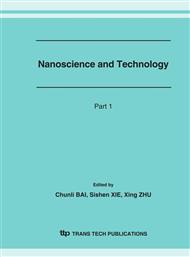p.449
p.453
p.457
p.461
p.465
p.469
p.473
p.479
p.483
Effect of Silicon Sources on Self-Assembly in Acidic Environment and Impact on Morphology and Grain Size of Mesoporous Material
Abstract:
Alkaline hydrothermal process with using cetyl-trimenthylammonium bromide as template is typical method to prepare MCM-41 mesoporous material. Synthesis in acid media was seldom researched deeply. With cheap inorganic water glass, effect of different silicon sources on self-assembly in acid media was investigated. Not like typical MCM-41 mesoporous materials, it is found that results of analysis are a little different and morphology of mesoporous materials synthesized in acid media does not rely on silicon sources, regardless of organic or inorganic silicon source. It is also noticed that nanometer granule of mesoporous material can be directly made by simply adjusting water dosage, which open up a new way for preparing nanometer material by self-assembly.
Info:
Periodical:
Pages:
465-468
Citation:
Online since:
March 2007
Authors:
Keywords:
Price:
Сopyright:
© 2007 Trans Tech Publications Ltd. All Rights Reserved
Share:
Citation:


